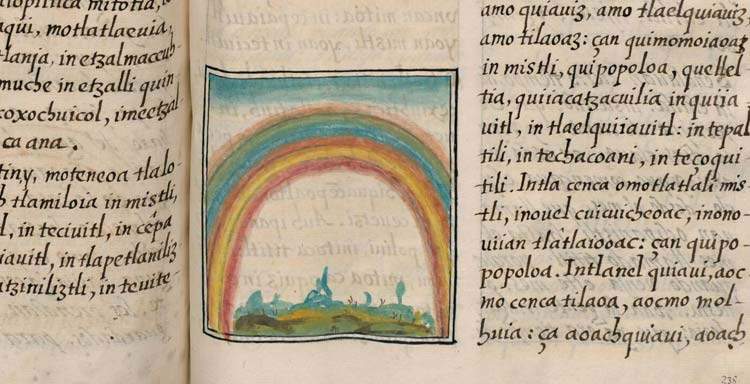Milan, at MUDEC there is an exhibition all about the rainbow
Inspired by The Rainbow Show, an exhibition held in San Francisco in 1975, Milan ’s MUDEC is proposing from Feb. 17 to July 2 an exhibition project made up of different narratives related to therainbow, understood as a natural, cultural, spiritual and human phenomenon. The exhibition RAINBOW. Colors and Wonders among Myths, Arts and Science opens with a site-specific installation that American artist Cory Arcangel (1978), conceived specifically for the iconic agora space: a rainbow gradient carpet generated through computer-graphics transforms the optical phenomenon from a digital abstraction to a tangible object.
Entering the exhibition halls, a total experience is created by the work of Laura Grisi (1939-2017): through a beam of light that is refracted by a prism, the visitor witnesses a physical yet miraculous phenomenon. An ancient prodigy, also depicted by Sinibaldo Scorza ’s Sacrifice of Noah after the Flood (1589-1631), where the rainbow is a symbol of divine forgiveness and a promise of new life. Another section of the exhibition, set up in collaboration with the Museum of Natural History in Milan, explores how animals perceive color, questioning the primacy of human vision. It also reflects on color as a communication system, which can be seen not only in the colorful plumage of birds, but also in the garish hues of the Australian spider Maratus, filmed by Maria-Fernanda Cardoso (1963).
To explore the physics of the rainbow and the ways in which artists have investigated the phenomenon of refraction, old scientific volumes, optical instruments from the “Sarpi” High School in Bergamo and a work by Amalia del Ponte (1936), a variation of her legendary prisms created just for the exhibition, will be on display. The analytical study of forms and light phenomena can also be recognized in the works of Giacomo Balla, Josef Albers, Frank Stella and Shá¿¡saku Arakawa.
The purity of structure and chromatic order formally bring the works of the modernists closer to the installation of contemporary Polish artist Mirosław Bałka (1958-) and the precious funerary fabric(Peru, Nasca culture, 1st century B.C.) from the multicolored interwoven threads.
The exhibition continues with a study of the different symbolic meanings of the rainbow through pieces from the MUDEC collections and loans that restore the complexity of the rainbow serpent mythology, spread from the ancient cultures of South America to Asia, from Africa to Australia. The second room opens with environments created “by” and “with” color. Photographs by American Judy Chicago (1939) document her historical performances using colored fumes; Lithuanian Alexandra Kasuba’s (1923-2019) model testifies to the environment she created for The Rainbow Show; Diana Thater’s video proposes a reflection, through spectrum colors, between eternal and fleeting time.
Finally, a critical reflection on the rainbow theme is conducted by Flavio Favelli (1967). The latter arranges stamps in his work in shades of rainbow tones. Behind such graphic beauty, however, lies a controversial reality: in fact, the stamps used date back to Italy’s colonial past.
Rainbow is the first exhibition that, as part of a renewed MUDEC program, is being developed as an ever-evolving cross-cultural event. Anticipated in November 2022 by the participatory artwork #OneLove by artist Norma Jeane in the Spazio delle Culture, it expands to public space: in April 2023, Flavio Favelli’s mural will be inaugurated in the courtyards of the former Ansaldo. The Rainbow program includes events in collaboration with the Planetarium and the Museum of Natural History, and will be enriched in May 2023 by Black Arts School Modality, a series of workshops, conceived by American curator Romy Crowford, aimed at shaping knowledge of the Black Arts Movement.
Artists in the exhibition: Josef Albers, ShÅ«saku Arakawa, Cory Arcangel, MirosÅ‚av BaÅ‚ka, Giacomo Balla, Maria-Fernanda Cardoso, Judy Chicago, Amalia Del Ponte, Flavio Favelli, Laura Grisi, Aleksandra Kasuba, Auguste and Louis Lumière, John Mawurndjul, Kathleen Petyarre, Sinibaldo Scorza, Frank Stella, Diana Thater.
For all information, you can visit the official MUDEC website.
Image: Friar Bernardino de Sahagún, Historia general de las cosas de Nueva Espaňa, vol. II (1575-77; manuscript with watercolor drawings, folio 306 x 210 mm; closed volume 315 x 220 x 43 mm; open volume 315 x 470 mm; Florence, Biblioteca Medicea Laurenziana, Med. Palat. 219)
 |
| Milan, at MUDEC there is an exhibition all about the rainbow |
Warning: the translation into English of the original Italian article was created using automatic tools. We undertake to review all articles, but we do not guarantee the total absence of inaccuracies in the translation due to the program. You can find the original by clicking on the ITA button. If you find any mistake,please contact us.



























